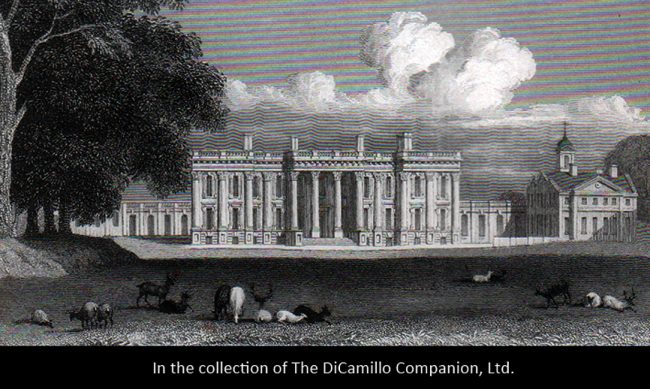
An 1831 engraving of the House from "Neale's Views of Seats"
Built / Designed For: Charles Talbot, 12th Earl of Shrewsbury and later 1st and last Duke of Shrewsbury
House & Family History: Heythrop was built for Charles Talbot, 12th Earl of Shrewsbury, using the financial reward he received for being part of the group that invited William of Orange to assume the throne of Great Britain as William III. The new king also created Talbot a duke, but, when he died with no male heirs, the dukedom died with him. Between 1743 and 1786 the 14th Earl was said to have spent £5,000 on the decoration of just the Wedgwood Room in the house, continuing the tradition of extravagance at Heythrop. The house passed through the generations, until 1820, when it was leased to the 6th Duke of Beaufort, who used to bring his hounds from Badminton in Gloucestershire to hunt in what is today Heythrop Hunt country. In 1831 a huge fire left Heythrop a shell, with only its outer walls standing. The house remained a ruin for almost 40 years, until, in 1870, it was purchased by Thomas Brassey as a wedding gift for his son, Albert. Albert Brassey spent large sums to restore the house and grounds, living in Heythrop until his death in 1918. In 1921 the house, together with 500 acres, was purchased by the Society of Jesus as its British national headquarters. The Jesuits added new wings to the house and erected two residence halls; however, in 1969 they decamped to Oxfordshire and ultimately consolidated their operations in London. Soon afterward the National Westminster Bank purchased the house and estate, paying approximately £1 million; they spent another £1 million on restoration and renovation to turn Heythrop into their national training center. After NatWest was acquired by The Royal Bank of Scotland in 1999, the training center at Heythrop was closed and sold; the house is today an upscale hotel and conference center. One of the interesting survivals of the house is the "Snobs Tunnel," a sunken passageway that was built expressly for the use of tradesmen in the 19th century so as not to offend the eyes of the gentry by the movement of trades people.
Comments: Heythrop is considered Archer's most important country house.
Garden & Outbuildings: The two-acre walled garden is extant.
Architect: Alfred Waterhouse
Date: 1870-71Vitruvius Britannicus: V, pls. 82-85, 1771.
John Preston (J.P.) Neale, published under the title of Views of the Seats of Noblemen and Gentlemen in England, Wales, Scotland, and Ireland, among other titles: Vol. III, 1820.
Title: Country House in the 1980s, The
Author: Young, John
Year Published: 1981
Reference: pgs. 114-116
Publisher: London: George Allen & Unwin
ISBN: 0047200227
Book Type: Hardback
Title: Biographical Dictionary of British Architects, 1600-1840, A - SOFTBACK
Author: Colvin, Howard
Year Published: 1995
Publisher: New Haven: Yale University Press
ISBN: 0300072074
Book Type: Softback
House Listed: Grade II*
Park Listed: Not Listed
Past Seat / Home of: Charles Talbot, 12th Earl of Shrewsbury and 1st and last Duke of Shrewsbury, early 18th century. Henry Charles Somerset, 6th Duke of Beaufort, 18th century. Albert Brassey, late 19th-early 20th centuries.
Current Ownership Type: Corporation
Primary Current Ownership Use: Hotel
Ownership Details: Owned by Firoka Ltd. and operated by them as Heythrop Resort
House Open to Public: By Appointment
Phone: 01608-673-333
Fax: 01608-673-799
Email: [email protected]
Website: http://www.heythroppark.co.uk
Historic Houses Member: No